Figures & data
Figure 1. A: Entrainment of neural oscillations by a rhythmic exogenous acoustic stimulus (e.g. a regular tone sequence). Rhythmic edges or peaks in the amplitude envelope of the stimulus synchronise neural oscillation at stimulation frequency; B: Entrainment impossible in cases of non-rhythmic amplitude cues in speech stimulus; C: Intrinsic synchronicity of neural oscillations to a non-rhythmic acoustic stimulus (e.g. speech). Inferred and predictive linguistic knowledge (e.g. of abstract syntactic structure or predicted words) deployed by endogenous signals (i.e. local-field potentials or slower-frequency neural oscillations) establishes continued oscillatory rhythmicity disguised as entrainment, in spite of lacking acoustic cues.

